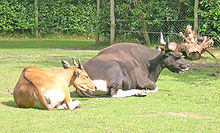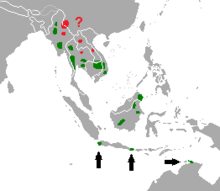Bos javanicus
| Banteng | |
|---|---|
 |
|
| Java banteng cow (left) and bull (right) | |
| Scientific classification | |
| Kingdom: | Animalia |
| Phylum: | Chordata |
| Class: | Mammalia |
| Order: | Artiodactyla |
| Family: | Bovidae |
| Subfamily: | Bovinae |
| Tribe: | Bovini |
| Genus: | Bos |
| Species: | B. javanicus |
| Binomial name | |
|
Bos javanicus d'Alton, 1823 |
|
| Subspecies | |
|
B. j. birmanicus |
|
 |
|
| Range map | |
B. j. birmanicus
B. j. javanicus
B. j. lowi
B. j. domesticus
The banteng (/ˈbæntɛŋ/) (Bos javanicus), also known as tembadau, is a species of wild cattle found in Southeast Asia.
Banteng have been domesticated in several places in Southeast Asia, and there are around 1.5 million domestic banteng, which are called Bali cattle. These animals are used as working animals and for their meat. Banteng have also been introduced to Northern Australia, where they have established stable feral populations.
These subspecies are recognised:
The banteng is similar in size to domesticated cattle, measuring 1.55 to 1.65 m (5 ft 1 in to 5 ft 5 in) tall at the shoulder and 2.45–3.5 m (8 ft 0 in–11 ft 6 in) in total length, including a tail 60 cm (2.0 ft) long. Body weight can range from 400 to 900 kg (880 to 1,980 lb). It exhibits sexual dimorphism, allowing the sexes to be readily distinguished by colour and size. In mature males, the short-haired coat is blue-black or dark chestnut in colour, while in females and young it is chestnut with a dark dorsal stripe. Both males and females have white stockings on their lower legs, a white rump, a white muzzle, and white spots above the eyes. The build is similar to that of domesticated cattle, but with a comparatively slender neck and small head, and a ridge on the back above the shoulders. The horns of females are short and tightly curved, pointing inward at the tips, while those of males arc upwards, growing 60 to 75 cm (24 to 30 in) long, and being connected by a horn-like bald patch on the forehead.
Banteng live in sparse forest where they feed on grasses, bamboo, fruit, leaves, and young branches. The banteng is generally active both night and day, but in places where humans are common, they adopt a nocturnal schedule. Banteng tend to gather in herds of two to 30 members.
...
Wikipedia

